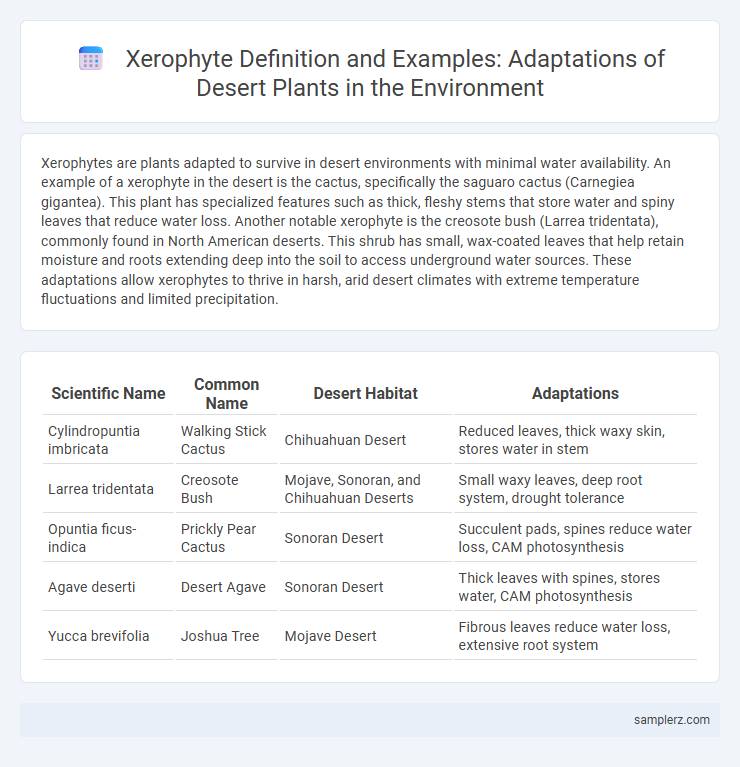Xerophytes are plants adapted to survive in desert environments with minimal water availability. An example of a xerophyte in the desert is the cactus, specifically the saguaro cactus (Carnegiea gigantea). This plant has specialized features such as thick, fleshy stems that store water and spiny leaves that reduce water loss. Another notable xerophyte is the creosote bush (Larrea tridentata), commonly found in North American deserts. This shrub has small, wax-coated leaves that help retain moisture and roots extending deep into the soil to access underground water sources. These adaptations allow xerophytes to thrive in harsh, arid desert climates with extreme temperature fluctuations and limited precipitation.
Table of Comparison
| Scientific Name | Common Name | Desert Habitat | Adaptations |
|---|---|---|---|
| Cylindropuntia imbricata | Walking Stick Cactus | Chihuahuan Desert | Reduced leaves, thick waxy skin, stores water in stem |
| Larrea tridentata | Creosote Bush | Mojave, Sonoran, and Chihuahuan Deserts | Small waxy leaves, deep root system, drought tolerance |
| Opuntia ficus-indica | Prickly Pear Cactus | Sonoran Desert | Succulent pads, spines reduce water loss, CAM photosynthesis |
| Agave deserti | Desert Agave | Sonoran Desert | Thick leaves with spines, stores water, CAM photosynthesis |
| Yucca brevifolia | Joshua Tree | Mojave Desert | Fibrous leaves reduce water loss, extensive root system |
Introduction to Xerophytes in Desert Ecosystems
Xerophytes in desert ecosystems, such as cacti and succulents, exhibit specialized adaptations like thick cuticles and deep root systems to conserve water in arid conditions. These plants play a crucial role in stabilizing soil and supporting desert biodiversity by providing habitat and food for various animals. Their physiological and structural traits enable survival amidst extreme temperatures and minimal rainfall characteristic of desert environments.
Unique Adaptations of Desert Xerophytes
Desert xerophytes such as the saguaro cactus exhibit unique adaptations including thick, waxy cuticles and pleated stems that maximize water storage and minimize evaporation. Their deep, extensive root systems enable efficient water absorption from scarce rainfall. Specialized photosynthesis processes like CAM allow these plants to fix carbon dioxide at night, reducing water loss during daytime heat.
Cacti: Iconic Xerophytes of the Desert
Cacti are iconic xerophytes adapted to arid desert environments through their thick, fleshy stems that store water and spines that reduce water loss and protect against herbivores. Their shallow, widespread root systems efficiently capture limited rainfall, while CAM photosynthesis allows them to minimize transpiration by opening stomata at night. Species like the Saguaro cactus (Carnegiea gigantea) exemplify these specialized adaptations, thriving in harsh conditions with extreme temperature fluctuations and scarce water availability.
Agave Species: Water-Saving Wonders
Agave species, native to arid desert regions, exemplify xerophytes with remarkable water-saving adaptations such as thick, fleshy leaves and a waxy coating that minimizes moisture loss. Their CAM (Crassulacean Acid Metabolism) photosynthesis allows stomata to open at night, reducing water evaporation during hot daytime hours. These water-conserving features enable agaves to thrive in harsh desert environments with minimal rainfall.
Yucca Plants: Surviving Arid Conditions
Yucca plants exemplify xerophytes by thriving in harsh desert environments with minimal water. Their thick, wax-coated leaves reduce moisture loss while deep root systems efficiently access underground water. Adaptations like CAM photosynthesis allow Yuccas to conserve water by opening stomata at night, ensuring survival in arid conditions.
Succulent Shrubs: Storing Water for Survival
Succulent shrubs such as the Creosote Bush and Desert Lavender exemplify xerophytes adapted to desert environments by efficiently storing water in their thick, fleshy leaves and stems. These plants utilize specialized tissues to retain moisture, enabling survival through prolonged droughts and extreme temperatures. Their water-storage capability is crucial for maintaining metabolic functions and sustaining life in arid ecosystems.
Creosote Bush: Master of Heat Resistance
Creosote Bush (Larrea tridentata) thrives in arid desert environments, showcasing exceptional heat and drought resistance. Its deep root system and waxy leaves minimize water loss, allowing survival in extreme temperatures exceeding 45degC. As a dominant xerophyte in North American deserts, it plays a crucial role in stabilizing soil and supporting desert ecosystems.
Mesquite Trees: Deep-Rooted Xerophytes
Mesquite trees are exemplary xerophytes in desert ecosystems, characterized by their extensive deep root systems that can reach depths of up to 50 feet. These deep roots maximize water absorption from underground aquifers, ensuring survival during prolonged drought periods. Adaptations such as small, waxy leaves reduce water loss, making mesquite trees highly efficient in arid environments.
Euphorbia: Desert Resilience in Action
Euphorbia species exemplify xerophyte adaptations with their succulent stems that store water and spiny structures minimizing transpiration in arid desert environments. These plants utilize Crassulacean Acid Metabolism (CAM) photosynthesis to optimize water use efficiency under extreme drought conditions. Their resilience contributes significantly to desert ecosystem stability by providing shelter and sustenance for specialized wildlife.
Importance of Xerophytes for Desert Biodiversity
Xerophytes like cacti, agave, and creosote bush play a crucial role in desert ecosystems by conserving water and providing habitat and food for various desert wildlife. Their adaptations, such as thick cuticles and deep root systems, enable them to survive extreme aridity, supporting biodiversity in harsh desert conditions. These plants contribute to soil stabilization and nutrient cycling, ensuring the sustainability of desert environments.

example of xerophyte in desert Infographic
 samplerz.com
samplerz.com